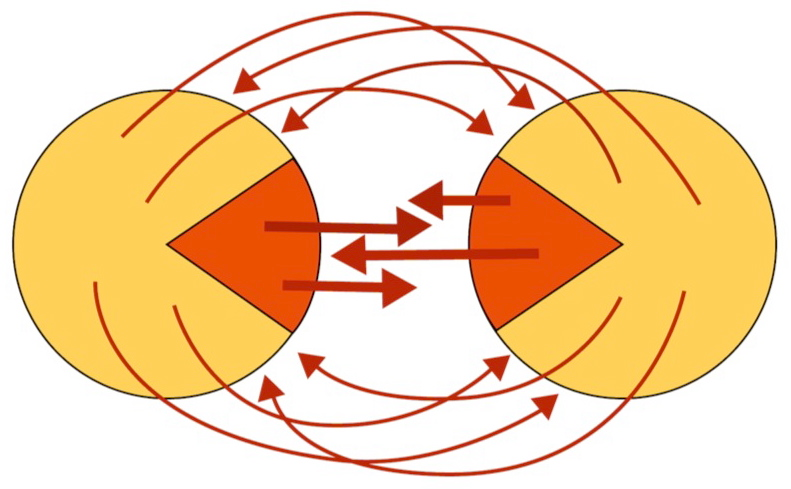
 Click here
Click hereThe Healthcare institution case
The problem
In a residence for assisted living inhabited by patients of a care institution in post-treatment, a patient had brutally murdered a housemate fellow patient. The residence was supervised and managed by the institution. The murder caused a shock to all involved, relatives and employees of the institution. Contacts between the victim’s relatives and staff members of the institution clashed after the murder. The relatives were upset. They blamed the institution for having allowed the perpetrator to live in this house and stated that the institution had not sufficiently supervised the residents.
A lawyer had filed a complaint against the institution on behalf of the relatives.
The approach
By way of an experiment, the institution’s lawyer proposed that all the relatives and staff members involved including the two lawyers should be brought together in a meeting to be chaired by the medical director. The relatives could then express what was bothering them and the staff members and the board could then explain how they had dealt with their tasks and responsibilities in the situation. The board sympathized with the plan.
In preparation, the lawyer held individual consultations with the staff members involved to listen to their stories and to request their participation in the meeting. Almost all employees agreed.
The invitation was sent and was accepted by the relatives soon afterwards.
The meeting
The meeting room had been prepared by placing the chairs in a large circle in the middle. Each participant would have an equal place and no one would sit opposite another.
The medical director welcomed the participants with a brief memorial for the deceased patient. He mentioned that the meeting had been convened as not everything had gone well after the sad event and that the institution wanted everyone to express what had not gone well and what could be improved. He invited the relatives to tell one by one what was bothering them. And he asked not to interrupt each other, as everyone would get a turn.
The relatives spoke freely about what disturbed them. They expressed criticism, emotions, worries, experiences and wishes. After that, the staff members and the medical director explained how they had coped with the situation.
It was an intense meeting. The participants listened well to each other. Questions brought background information to the table. Openness in the meeting softened contradictions and calmed down emotions. Understanding emerged.
When everyone had finished speaking, the relatives’ lawyer requested a continuation of the meeting a few weeks later. He wanted to consult quietly with his clients.
All the participants agreed on this.
The solution
About a month later, the meeting was continued. All participants were present again. The meeting was short. On arrival already the ice was broken. The relatives and the staff members shook hands warmly. Everyone was happy to see each other again in a different way. The relatives had come to see the staff members as fellow sufferers somehow. They were grateful that they had been able to express their frustration. It was clear that they could now close this part of the problem with a good feeling. The same was true for the staff members.
To settle the dispute, it was agreed that the healthcare institution would reimburse the costs incurred by the relatives in attending the two meetings, and that the institution would also bear the modest costs of their lawyer. In return, the relatives withdrew their complaint.
The participants said goodbye to each other in a moving way.
What made the solution sustainable?
The solution included much more than just settling the actual dispute about resentment and distrust:
- The way in which the solution was achieved had given the lives of those involved a positive impulse after the horrific murder.
- This positive experience has alleviated the pain of the murder for all.
- Afterwards, no one has any negative feelings (resentment, distrust or guilt) about the tactless behavior after the murder.
- Mutual trust has been strengthened, both internally within the healthcare institution and in relationship with the relatives, despite the criticisms they had expressed.
What is needed to achieve a sustainable solution:
- Respect for all involved, self-respect, respect for human dignity and respect for the problem as a whole (in this case, not only the resentment and distrust, but also the context of the murder which had shocked all involved).
- An equal opportunity for those involved to share emotions and concerns in a setting that is relevant to the solution.
- Reversing the negative spiral of the conflict or problem by giving those involved a positive impulse with which they can go on in their lives.
How would the legal path have looked like?
A legal battle would have been fought over legal questions:
- Are the relatives admissible in their complaint?
- Did the healthcare institution fail in its duty of care?
- If so: What damage must be compensated?
Clearly, the dramatic event would have been even more painful for all involved:
- The proceedings would have caused deep wounds that would have generated long-term negative memories.
- The final result would never be satisfactory to anyone.
- No one would have become happier.
- Lawyers certainly would have made good money from it.


